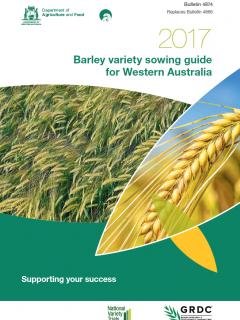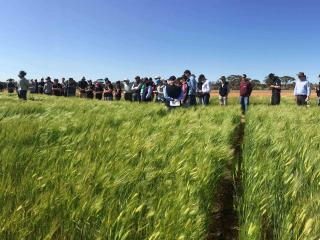Western Australia
September 15, 2016

Barley growers deliberating on what to sow next year can find all the latest variety information in an updated guide available online.
The 2017 Barley variety sowing guide for Western Australia harnesses results from Department of Agriculture and Food research trials, the Grains Research and Development Corporation’s National Variety Trials and research from the public and private sectors.
The document provides valuable information about the performance of currently available varieties, including grain yield comparisons, agronomic attributes, disease resistance and herbicide tolerance, in addition to a comprehensive description of individual lines.

The sowing guide also features a market overview, provided by the Grains Industry Association of Western Australia’s Barley Council.
Interest in sowing barley has grown in recent years, with the Association forecasting an estimated 1.25 million hectares sown across the grainbelt in 2016, set to yield 3.4 million tonnes.
Department barley development officer Georgia Trainor said the updated sowing guide provided a one-stop-shop for information about 10 feed, six malt and one food variety.
Ms Trainor said the document featured details about three new feed varieties, Compass, Rosalind and Spartacus CL.
“Compass is derived from Commander but has improved grain yield, plumpness and agronomic characteristics,” she said.
“Rosalind looks a lot like Dash, Hindmarsh and La Trobe but it flowers about 10 days earlier than Dash and two to three days later than Hindmarsh and La Trobe. Spartacus CL is an imidazolinone tolerant barley with similar grain yield, quality, phenology and agronomic features to Hindmarsh and La Trobe.
“The sowing guide provides a comprehensive overview about how these new lines have performed and compare with existing varieties, as well as their disease resistance ratings.”
Ms Trainor said several other malt and feed varieties would be high on growers’ list of what to sow.
“Bass is an established malt variety that has strong market demand, backed by the highest malt selection rate over the past couple of seasons,” she said.
“Another malting barley to watch is Flinders, which is a new line being evaluated for its suitability for international brewing markets. However, limited segregation opportunities are expected in 2017, until full market acceptance is achieved.
“Fathom is a feed barley with good production potential, having the best tolerance to spot type net blotch but it yields up to 0.2 tonnes per hectare lower than Hindmarsh and La Trobe across a range of environments.”
Growers can compare all these and other varieties quickly and easily via the factsheets at the back of the sowing guide.
The 2017 Barley variety sowing guide for Western Australia is available on the department’s website or the GRDC website, and it will be posted to growers via GRDC’s Groundcover magazine.
The information will also be available in the department's MyCrop Barley mobile app.